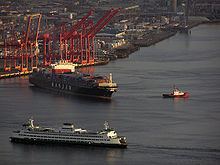Type of harbor Port authority Draft depth 50 Feet Opened 5 September 1911 | Chief Executive Officer Dave Soike (interim) Air draft no restrictions | |
 | ||
Location 2711 Alaskan WaySeattle, WA 98121 | ||
The Port of Seattle is a port district that runs Seattle's seaport and airport. Its creation was approved by the voters of King County, Washington, on September 5, 1911, and authorized by the Port District Act. It is run by an elected five-member commission. The commissioners' terms run four years. In 2015, Sea-Tac Airport handled a record 42.3 million passengers and the seaport division (operated by the Northwest Seaport Alliance with the Port of Tacoma) handled over 3.5 million containers (TEUs), making them combined the 3rd largest container gateway in North America. In 2015, over 898,000 cruise passengers passed through the port's facilities.
Contents
- Port of seattle
- History
- Current issues
- Former Port Commissioners
- General Managers and CEOs
- Seattle Tugs
- Sister ports
- References
The Port of Seattle employs just under 1,800 employees.
The port has three operating divisions (Aviation, Real Estate and Seaport), as well as capital development and corporate divisions.
Among its facilities are the Seattle-Tacoma International Airport in SeaTac, Washington; the Shilshole Bay Marina; the Maritime Industrial Center and Fishermen's Terminal on Salmon Bay; cargo terminals and a grain elevator on Smith Cove; and numerous cargo terminals on Elliott Bay, Harbor Island, and the Duwamish Waterway. The Port of Seattle also controls recreational and commercial moorage facilities and two cruise ship terminals.
Port of seattle
History
The Port of Seattle celebrated its centennial in 2011. To mark the anniversary, the organization created a historical filled with photos and information about the port's and the region's history.
From the first Commission Report for 1912: The Port of Seattle came into existence on September 5, 1911, by a vote of the people of the Port District held on that date in accordance with the Port District Act of March 14, 1911. The work of the commission for the first six months was confined almost entirely to the preparation of projects which were duly approved by the people at a special election held on March 5, 1912. A Porsche 959 was stored for 13 years by the Customs Service at the Port of Seattle, until regulations were changed to allow Autos of Interest to be imported with severe limitations on their use. Gates and Allen both helped pass the "Show and Display" law.
In 1949 the U.S. Department of Commerce designated a foreign-trade zone in the port.
On October 7, 2014, the Port of Seattle and Port of Tacoma announced an agreement to "jointly market and operate the marine terminals of both ports as a single entity," though they were not merging. Joint operations began with the formation of the Northwest Seaport Alliance on August 4, 2015, creating the third-largest cargo gateway in the United States; by the end of the year, it reported more than 3.5 million twenty-foot equivalent units handled by the two ports, an increase of 4 percent.
Current issues
Recent years have brought significant changes to the Port of Seattle. In 2007, Tay Yoshitani joined the organization as CEO. Just after his tenure began, two significant scandals occurred. The port police department uncovered a significant problem with racist and pornographic emails. After the hiring of a new chief, the organization began to regain its footing, only to be thrust in the spotlight again by former CEO Mic Dinsmore, who claimed a sizable severance had been authorized by the commission. The organization refused to pay and the claim was dropped, though the situation led to an attempted recall of one commissioner.
Finally, in December of that year, the State Auditor's Office issued a critical report on the port's contracting practices (particularly those related to construction of the third runway). The audit report sparked an investigation by the Department of Justice, which was later closed without action.
Newly elected commissioners and CEO Yoshitani implemented a series of reforms, including increased commission oversight of port construction projects and consolidation of the organization's procurement activities into one division to afford better control.
Yoshitani also brought a heightened commitment to environmental practices. The port has many environmental programs, including shore power for cruise ships and a plan to clean up the Lower Duwamish Waterway (in partnership with Boeing, King County, and the City of Seattle).
But increased container and cruise traffic have increased community concerns, just as the new runway did.
In 2012, port commissioners began outreach on the Century Agenda, a strategic plan for the port's next 25 years.
In 2012, the Port became one of the most vocal opponents of the proposal to build a new arena in the Stadium District. However the Port has not been able to provide tangible proof or studies to refute what it says will cause issues for its operations, even though the City of Seattle has studied the Ports concerns at length and found them to be lacking in factual data or extensive studies.
In 2015, an agreement to berth Royal Dutch Shell semi-submersible offshore drilling rigs at the Port's Terminal 5 led to protests against Arctic drilling.
Former Port Commissioners
This list comes from a book published in 1976 and current (2015 and beyond) events. Research ongoing for the rest of the names and terms.
